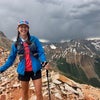New perk! Get after it with local recommendations just for you. Discover nearby events, routes out your door, and hidden gems when you sign up for the Local Running Drop.
Running a wild 167 miles from Arizona to Utah in North America’s first self-supported stage race
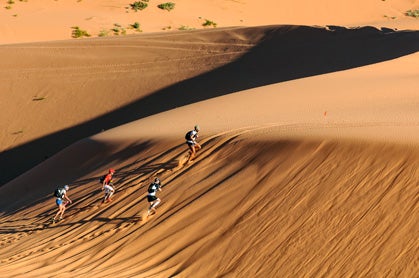
The men’s lead pack traverses sand dunes near sunset near stage 3, the longest stage of the Grand to Grand Ultra. Photo courtesy of Grand to Grand Ultra.
This story originally appeared in our January of 2013 issue
Running up a steep sand dune feels like scrambling up a slick snow bank: You plant one foot and it slides back, so you quickly plant the other and it slides too, and when both feet slip uncontrollably you flop forward on your hands. You might eventually give up running or walking and resort to crawling, which is what I did under a starry sky in the Coral Pink Sand Dunes State Park near Kanab, Utah.
Sand caked my hand-held water bottles and sweaty limbs. Sand seeped into my socks despite the full-cover gaiters on my shoes. Sand scratched my eyes as I strained to spot the small orange flags marking the course.
Ahead and behind, spread out over miles, dozens of other runners shared this journey as part of the inaugural 167-mile, seven-day, self-supported Grand to Grand Ultra, the first race of its kind in North America. But at around 10 p.m. on this September night, I felt very alone—and very tired. In three days, I had put 95 hard desert miles on my legs.
My shoulders ached from a pack that held my food and gear, and I still had another 12 miles to go before reaching camp, and 60 miles more in the four days to come.
An hour earlier, when I reached the dunes in the twilight glow, they spread for miles like smooth, salmon-hued mounds of meringue that curved and formed fin-like ridges. Their softness and bareness stood in stark contrast to the brushy, rocky landscape of prickly cacti, gnarled piñon and barbed sagebrush that we had spent the first two days running through. The beauty and my accomplishment filled me with happiness that bordered on euphoria. Predictably, a comedown was imminent. Energy and spirits plunged after dark.
Footprints from the frontrunners blemished the dunes’ surfaces but showed the way—until they forked and faded to black. Two roads diverged in a pink dune … Lightheaded, I tried to remember the Frost poem that my sixth-grade son had to memorize for school. One foot in front of the other crowded out all thoughts.
A couple of miles later, the dunes flattened and transitioned to a sandy road. I could run again. I could see more clearly. In fact, I could see the faint glow of something ahead on the ground. It looked like a dim headlamp. Worried that another runner had dropped his or her source of light, I approached to pick it up.
The glow, it turned out, was the reflection of the light from my headlamp in a pea-sized eye. The eye was in a triangle-shaped head. And the head belonged to the coiled body of a large snake.
I shrieked, jumped back and sprinted down the road—as fast as one can sprint in ankle-deep sand, that is. The near-venomous encounter gave me enough of an adrenaline jolt to catch the lead woman about a mile later.
Several days earlier, before the race began on September 23, 60 runners from all over the globe showed up in Kanab, a.k.a. “Utah’s Little Hollywood.” Our arrival seemed like the biggest thing to hit the two-stoplight town since Clint Eastwood, Sidney Poitier and other stars visited to film their Westerns.
The name “Grand to Grand” comes from the event’s starting point, at the north rim of the Grand Canyon, and its finish line, near the Grand Staircase-Escalante National Monument in Utah. Kanab sits roughly in the middle, near the Arizona-Utah border.
Dozens of local volunteers rolled out the welcome wagon, donning Stetson hats and Wrangler shirts to host a chuckwagon-style pre-race dinner. The close-knit Mormon community is trying to open itself up and become a destination for adventure seekers visiting what’s known as the geologically exquisite “Grand Circle” formed by Southern Utah’s national parks and the Grand Canyon.
I first met the other racers on a bus ride from the Las Vegas airport. The participants represented 15 different countries, and some wore patches on their shirts from Morocco’s seven-day Marathon des Sables or Racing the Planet’s 4Desert series. Stories buzzed around the bus about the dreaded salt flats in Chile’s Atacama crossing and a near-fatal stretch in a multi-day race in Namibia, as if it’s normal to travel the globe to run 250K (155-mile) self-supported stage races.
When they queried about my background, I’d say, “Northern California. … Nope, never done a multi-day race. … Nope, never done a 100-miler.”
I had never embarked on a week of trail running anything like this: back-to-back long runs, with the course divided into six stages of 31 miles, 29, 47 (followed by a rest day), 25, 26 and 9. Carrying all my food and gear on my back, ascending more than 18,000 feet on rolling hills and steep buttes at high altitude. Sweating through hot days, shivering on cold nights. Sharing a tent with strangers. Marveling at the Southwest’s multi-hued, layered rock formations. And running on sand—lots of sand.
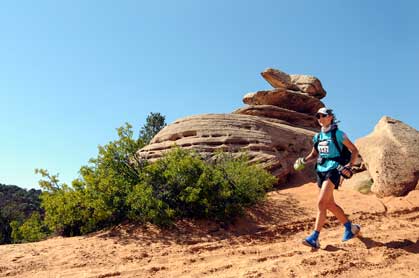
The author runs past one of the course’s distinctive rock formations. Photo courtesy of Grand to Grand Ultra.
The idea for the Grand to Grand Ultra came to the event’s co-director, Colin Geddes, while crewing for his wife, Tess, at a 50-miler in the Florida Keys back in May of 2010.
Tess, originally from the Philippines, started running stage races in the Sahara and other deserts in 2005. Colin, a Scottish investment banker who’s not much of a runner himself, enjoyed following and pacing her.
At the Florida race, and again five months later while with Tess at the Javelina Jundred ultra in Arizona, Colin began asking, “Why isn’t there a Marathon des Sables-type event here in North America?”
“It seemed the time was well overdue to have an event like this in America or Canada, because there’s real growth in stage races around the world,” says Colin.
Colin bounced the idea off Tess’s friend Terry Madl, who has run the Marathon des Sables three times as well as the 135-mile Badwater Ultramarathon. One thing led to another, and the trio formed Ultra Challenge America LLC, the company behind the Grand to Grand. By 2011, they were deep into planning the event.
They wanted an iconic desert location that would draw interest from overseas runners. The Grand Canyon seemed like an obvious choice. One problem: National Parks generally don’t allow competitive events. So they looked to the edges of the Grand Canyon, across wide swaths of open space managed by the Bureau of Land Management.
“Then Terry mentioned a place called the Grand Staircase,” says Colin. The Grand Staircase is a vast region southeast of Bryce Canyon National Park that’s been shaped over millennia into a lumpy geologic layer cake, with pink, vermilion, white and chocolate-colored cliffs.
The team designed a route that zigzags from the Grand Canyon’s rim to a finish line in the Dixie National Forest, overlooking the Grand Staircase.
On Saturday, September 22, we racers were supposed to report at Kanab’s old middle school for a gear check at 9:30 a.m., and then take shuttles to the first campground and start the race the following morning.
My 25-liter Inov-8 pack held approximately 19,000 calories for seven days, mostly energy gels, nut-butter pouches, bars, instant soup, instant oatmeal and dehydrated backpacker meals. Long underwear, a lightweight down jacket, an inflatable sleeping pad, a few toiletries and mandatory safety items took up the rest of the space. The race organizers provided communal tents and hot water, so runners wouldn’t need to carry a tent or stove. I strapped my ultralight down sleeping bag to the pack’s exterior and carried two hand-held water bottles. All together, the contents weighed just over 20 pounds.
Not wanting to be late, I double-checked directions with the lady at the front desk.
“Oh, sure, honey,” she told me, “just hang a left and go down Highway 89. You’ll see the high school, and the middle school is behind it. Can’t miss it.”
A red-rock butte with a giant white “K” monogrammed on its hillside looms over Kanab. Surveying the high-desert landscape, I caught my reflection in the glass lobby door and thought I could fit in with my son’s Boy Scout troop: American flag sewn on sleeve, pack snuggly strapped on.
Walking alone down the highway in the direct sun, I soaked through the armpits of the running shirt I would wear for the whole week. I reached the high school and calculated I had walked about a mile. Then I saw the middle school in the distance— deserted. Putting two and two together, I realized I should be at the old middle school around the corner from the hotel, not the new middle school. Panic rose in my chest.
I blinked back tears and thought, If I can get turned around in downtown Kanab, how will I find my way in the wilderness?
Blasting music jolted us awake at 6 a.m. on the morning of Stage 1. The lyrics I like to move it, move it, from the song by Crazy Frog, bounced off tent walls and down the nearby cliff that dropped into the Grand Canyon’s chasm.
The music was one of the race directors’ special touches, along with chairs around the campfires and two rows of Porta-Potties with hand sanitizer. Those who had done multi-day races overseas raved about the campsite “loos” and told horror stories of the pits they had squatted over at other events. “They’re spoiling us here,” said one happily.
Inside a white canvas tent, the seven people with whom I’d share the tent all week began to stir while I awkwardly changed clothes in my sleeping bag. We politely minded our own business and acted modestly on this first morning.
In one corner, Stephanie Case, 30, of Canada whispered to her boyfriend, Stuart Blieschke, of Australia and shared a laugh. The two became a couple after they ran the Gobi March, a 250K self-supported stage race, last June.
Ordinarily, Stephanie would be a top competitor, having won or placed second in the several prior stage races she ran around the globe. But she didn’t intend to push the pace at the Grand to Grand, because she and Stuart wanted to stick together all week.
Another elite female runner quietly packed her belongings in our tent: Sharon Gayter, 48, a top-ranked British ultrarunner who has won several international stage races and holds a world record for racking up 517 miles during a week’s worth of treadmill running. She looked quite thin and wore her short, graying hair in two tight French braids.
By contrast, our tentmate Dan Owings, 42, of Chicago had a cap of thick, curly hair that accentuated the roundness of his cheeks. He didn’t wear a watch, didn’t seem to be in any hurry and slyly tucked a beer can into his water-bottle holster to drink at the end of the first stage.
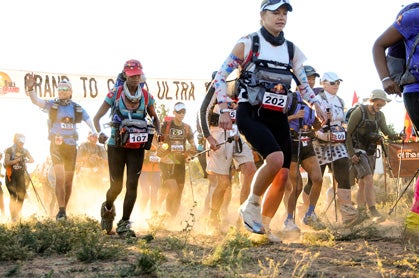
Runners at the start of one of the stages. Miranda Jamieson (#202) was the women’s winner of the final three stages. Photo courtesy of Grand to Grand Ultra.
Stage 1, 31.5 miles, began with relatively easy running on a downhill hard-packed road. Gayter took off with the front pack, which included Caroline Richards, 51, of England, also recognized as a potential winner of the women’s race. Richards had been a top finisher in self-supported stage races in places such as the Kalahari and Gobi deserts.
There was little question that the dominant male competitor would be Salvador Calvo Redondo, 50, of Spain, whose resume includes five wins in the past four years at 250K stage races. But two Italians were primed to stay on Redondo’s heels: Stefano Gregoretti and Davide Ugolini, both 38.
Under a slightly overcast sky, I settled into a comfortable pace, opened my eyes and ears to nature, and contemplated the vastness of the brown landscape dotted by grayish-green desert brush. It extended uninterrupted until hitting reddish escarpments far off in the distance.
The sun-parched plateau transitioned to a steady uphill, and the course led us through weeds and calf-high cacti in an off-trail stretch. Suddenly, I came upon Gayter sitting on a rock a few miles from the finish. She was picking cactus needles out of her shoe and said stoically, “This pack’s killing my shoulders.”
I reached the finish line in 6 hours 46 minutes. Tess Geddes wrapped me in a big hug and delivered the surprising news that I was the second woman, finishing five minutes behind Richards.
Near sunset, virtually every runner and volunteer stopped what they were doing and gathered at the finish line to applaud a pair of runners at the back of the pack, KiSuk Song and Kyung Tae Song of South Korea. Kyung Tae, 51, lost his sight 30 years ago in a grenade accident while serving in the military. The blind man was covering the entire course while holding onto his guide, KiSuk.
Stories from the trail passed among runners as we sat around a campfire. Using my spork to eat from a small foil bag of pasta, I felt unusually satiated from the food and profoundly satisfied from the run.
Stage 2, just under 29 miles, turned out to be a day of mishaps. I took off my shoes to fuss with blisters, and I tripped and fell into a juniper tree that punctured my water bottle. Everyone wilted in furnace-like heat—until the sky changed abruptly, and thunder and lightning roared in. Runners in the second half of the pack got soaked in a downpour. The campground turned into a bowl of red-dirt soup.
Heading into Stage 3, women held eight of the top 15 spots. I was the third female and ninth overall. While the top three men—Redondo, Gregoretti and Ugolini—had a commanding lead, the next four guys were pushing each other hard to secure a top-10 spot. It was anyone’s guess how the arduous 47-mile Stage 3, would play out.
The Grand to Grand throws in the added challenge of placing this long stage mid-week. Most self-supported, weeklong races follow a format of four days of around 25 miles each, a long stage of around 50 miles on Day 5, followed by a rest day and then a short sprint for the final stage. The Grand to Grand format meant we’d run the long stage with a heavier pack (since we hadn’t eaten through as much food at that point), and with the knowledge it would be followed by back-to-back stages of marathon distances. What’s more, the 47 miles held all kinds of terrain and obstacles while ascending 6400 feet and descending 5300 feet.
A mile into Stage 3, I heard a runner call out, “Look, a condor!” But I didn’t look because I was fully focused on gripping red rock and hoisting myself up a boulder on a vermilion cliff. Shortly thereafter, I had to concentrate on skating down slopes of slick rock that broke up the sandy hills like sheets of ice on a powdery ski run.
Richards, the female runner who dominated the first two days and leapfrogged with Gayter during the early hours of Stage 3, began to fade in the afternoon. I passed her at sunset as we ran along a highway toward the Coral Pink Sand Dunes park entrance.
I made it over those sand dunes and past that snake that looked like a dropped headlamp. The sandy road led deeper into the night, to the penultimate checkpoint around Mile 40. Gayter was sitting at that checkpoint and glanced up from her cup of soup with haunted-looking eyes. She put down her soup, took off, and I followed about 200 meters behind.
A cluster of orange ribbons indicated a turn into an off-trail section choked with brush and no discernable path. Gayter’s light bounced down the road straight ahead—she missed the turn. For a split second I considered letting her continue off course, but then I hollered, “Sharon!” Her headlight turned around and came back.
When she passed me, she stated the obvious, “Had to backtrack a bit,” and busted through the brush while swinging her trekking poles like scythes.
I hoped to stick with her for guidance and extra light. No such luck—while she fearlessly plowed ahead, I stepped gingerly over spiky yucca and whimpered when branches tugged at my hair. Several times, when I couldn’t spot any marker, I stopped cold to scan the woods and tried to suppress my fear.
Late in the night, alone and now hallucinating that the sticks on the ground were slithering, I did what any good paranoid person would do: I began talking out loud. But it didn’t sound like my voice. I seemed to channel a Minnesota granny plucked from a cruise ship.
“Oh, for Pete’s sake, wouldya look at that?” I talked to the trees and scolded the orange flags for hiding. “You betcha it’s dark, my heavens!”
Picking through piñon and talking myself down from an anxiety cliff, I made it through the woods and reached the campground at two minutes past midnight. I went straight to the medical tent to lie down on a cot, buried my face in a paper towel and had a big cry—the shoulder-shaking, sobbing kind. After a day that demanded so much strength and resolve, I could finally uncork my emotions.
Stage 3 put Gayter in the lead among women and fourth overall. I found myself 12 minutes behind her, second in the women’s field and fifth overall.
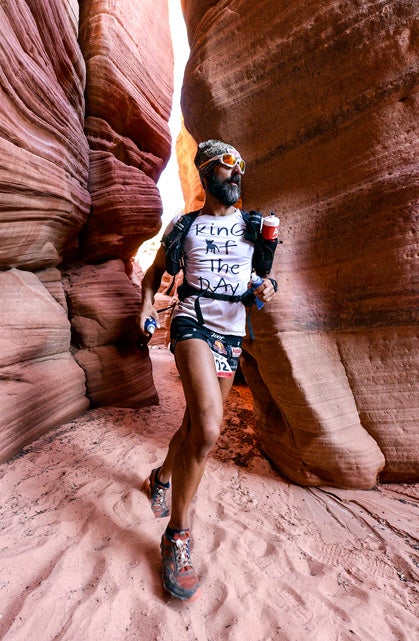
Stafano Gregoretti, who finished second overall, runs through Stage 5’s slot canyon. Photo courtesy of Grand to Grand Ultra.
Around noon the day after the long stage—our day of rest before Stage 4—I lay on my back next to Jared Knapp of Florida, a tentmate whom I got to know since we ran a similar pace. We both had our feet elevated on little camp chairs and were bantering about blisters, races, calories and gear. Roasting in the heat and having lost most modesty, I wore only a bra and underwear. Everyone’s damp running clothes decorated the canvas walls, hanging to dry from safety pins.
Next to us, Sharon cocooned in her sleeping bag, and Stephanie and Stuart rested on top of theirs.
Outside, a few runners continued to cross the finish because they had chosen to bivouac at a checkpoint along the course and complete the long stage in daylight.
Another tentmate, Lynne Hewett of Australia, pulled out her bag of tricks: surgical instruments, pills and bandages. She’s in her mid-40s and has short blonde hair. As a trauma nurse and veteran of several self-supported stage races, she came well prepared with medical supplies. Earlier, she gamely lanced and cleaned my infected blisters; now, she pulled out scissors and went to work on her own feet and shoes.
Her feet were so blistered and chafed from running in the Himalayas a few weeks earlier, and from the first two stages of the Grand to Grand, that she ran and hiked all 47 miles of Stage 3 in toe socks and flip-flops. She devised a new plan for the next stages: cutting openings in the sides of her shoes and sewing fabric gaiters around the vents to keep out debris.
Sharon emerged from her bag, cracked a joke about her disheveled hair and offered some of her meager food supplies to others. Stephanie, who works for the UN’s humanitarian relief in Afghanistan, mentioned that she’d have to return to running circles in a security compound in Kabul when this was over.
Lying there peacefully, I marveled at every single remarkable character at camp.
During the 25-mile Stage 4, my body rebelled. While others hammered down a slope of hard-packed dirt, my legs cramped and I couldn’t keep up.
A woman from the middle of the pack, Miranda Jamieson, unexpectedly surged toward the front. The 32-year-old Canadian triathlete, who lives in Florida, told me she walked most of the first three stages because she was so intimidated by the prospect of the 47-miler. “It sucked—I wanted to quit by the long stage.” Her feet ached, she said, because she hadn’t trained to hike.
Tess Geddes gently suggested she start running more to alleviate the pressure on her heels. As if by magic, Jamieson shifted to a faster gear and steadily picked off all the women in front, nearly catching the lead men. She repeated her incredible performance the next day and won the 26-mile Stage 5, though her late-week wins were not enough to move her near the top for cumulative time.
I watched Jamieson pull ahead as we traversed Stage 5’s slot canyon—a gorgeous, four-mile-long stretch of dry riverbed that runs through sculpted sandstone walls several stories high. The curved walls narrowed to doorway width in places, and the canyon floor plunged so precariously over boulders that wooden ladders were set out to aid our descent.
Fatigued, my eyes played tricks and saw the slot-canyon walls ripple while I imagined its shadowy crevices whispering, “You’re lucky the sky is clear.” In flash floods, slot canyons fill quickly and occasionally drown hikers.
By day’s end, I found myself third in cumulative time, behind Richards and Gayter. Spain’s Redondo broke away from Gregoretti and developed a 52-minute lead in the men’s race. Only one stage with a mere nine miles remained.
Green grass carpeted our last campground. We were leaving the desert behind and getting ready to summit a forest of pine and golden aspens.
The other runners and I huddled around a campfire and shivered in temperatures chilly enough to show our breath. On this last night, sensing the end was near, runners debated the degree of difficulty of the Grand to Grand.
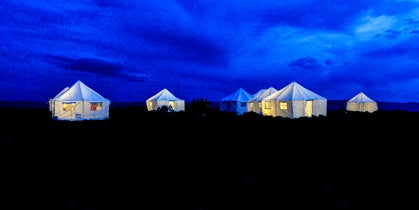
Tents, set up by an army of volunteers, accommodated eight runners each. Photo courtesy of Grand to Grand Ultra.
“From a running perspective, this was by far one of the most difficult stage races I have completed,” said Vincent Antunez of Texas, who has raced numerous ultras and five stage races around the world. But, “of all the events I have done, this was one of the best organized.”
My tentmate Stephanie called it “the ‘Goldilocks race’ of multi-day races: not too brutal, not too gentle, but just right. … Every stage was manageable, but definitely tough enough that you felt a real sense of accomplishment when you crossed the finish line.”
The organizers designed a staggered start for Stage 6, so we’d all finish around the same time and catch a bus to a post-race party in Las Vegas. With a few minutes to kill before the countdown, co-director Terry Madl asked our group, “Any last thoughts?”
Only half-joking, I blurted out, “I love you guys!”
We took off on a tree-lined trail carved into an alpine slope that supported sandstone formations shaped like giant totem poles. We ran up more than 1000 feet to reach the summit, and when I crossed under the finish banner, I burst into tears while hugging Tess Geddes.
My cumulative time of 43 hours 5 minutes placed me third woman and seventh overall, behind Gayter (1st woman in 42:32) and Richards (2nd in 42:52). Redondo won the race in 34:10, followed by Gregoretti (35:02) and Ugoline (36:57). Of the 60 who started, 48—including the blind Korean and his guide—made it.
As I stood on a cliff near the finish line and looked down on pinkish and golden rock spires carved into the steps of the Grand Staircase, relief and joy conflicted with grief that the week’s journey was over and that goodbyes were imminent.
I embraced my tentmates as we gazed at verdant, forested slopes that descended southward and blended into a panorama of pale-colored desert plateaus. Hidden in the horizon, tucked behind far-away mountains barely discernible to the naked eye, was our starting point at the Grand Canyon’s edge.
Sarah Lavender Smith lives in the San Francisco Bay Area. Read about her Grand to Grand Ultra training and gear on her blog, TheRunnersTrip.com.
The World’s a Stage
Week-long, self-supported races of approximately 250K (155 miles) and six stages unless otherwise noted below. Some are sold out for 2013 and are accepting registrations for 2014.
> Atacama Crossing (Chile)
March 3, 2013; and Oct. 5, 2014. 4deserts.com/atacamacrossing
> Marathon des Sables (Morocco) April 5, 2013; and April 4, 2014. darbaroud.com (website for USA and Canada registration: dreamchaserevents.com/Races/Marathon-des-Sables)
> The Track Outback Race
(Australia, 520K, 9 stages)
May 8, 2013; and again in 2015. canal-aventure.com/infos
> Jungle Ultra
(Peru, 230K, 5 stages)
May 24, 2013. beyondtheultimate.co/races/the-jungle-ultra
> Gobi March (China)
June 2, 2013; and June 1, 2014. 4deserts.com/gobimarch
> Mountain Ultra
(Colorado, 220K, 5 stages)
Aug. 2, 2013. beyondtheultimate.co/races/the-mountain-ultra
> RacingThePlanet Iceland
Aug. 4, 2013. 4deserts.com/beyond/Iceland
> European Ultra
(Portugal, 120K, 3 stages)
Sept. 20, 2013. beyondtheultimate.co/races/the-european-ultra
> Grand to Grand Ultra
(Arizona/Utah)
Sept. 22, 2013. g2gultra.com
> Kalahari Augrabies Extreme
Marathon (South Africa)
Oct. 17, 2013. extrememarathons.com
> Ultra Africa Race
(Cameroon, 200K, 5 stages)November 2013 and 2014 (dates TBA). canal-aventure.com/infos
> Desert Ultra (Namibia)
Nov. 15, 2013. beyondtheultimate.co/races/the-desert-ultra
> Ultra India Race (200K, 5 stages)Jan. 14, 2014. canal-aventure.com/infos
> Ice Ultra
(Sweden, 230K, 5 stages)
Feb. 14, 2014. beyondtheultimate.co/races/ice-ultra
> Sahara Race (Egypt)
Feb. 16, 2014. 4deserts.com/sahararace
> RacingThePlanet Madagascar
Aug. 31, 2014. (website not yet live; will be located in 4Deserts.com’s Roving Race section)
> The Last Desert (Antarctica)
Nov. 16, 2014. 4deserts.com/thelastdesert (note: an invitation-only event for those who have completed two of the four events in the 4Deserts series above)
